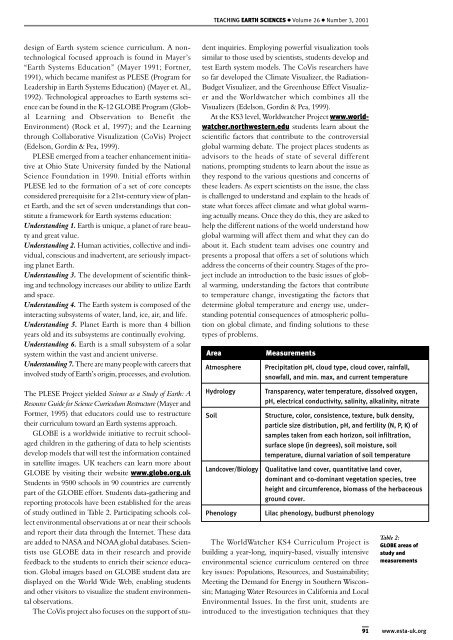teaching - Earth Science Teachers' Association
teaching - Earth Science Teachers' Association
teaching - Earth Science Teachers' Association
Create successful ePaper yourself
Turn your PDF publications into a flip-book with our unique Google optimized e-Paper software.
TEACHING EARTH SCIENCES ● Volume 26 ● Number 3, 2001<br />
design of <strong>Earth</strong> system science curriculum. A nontechnological<br />
focused approach is found in Mayer’s<br />
“<strong>Earth</strong> Systems Education” (Mayer 1991; Fortner,<br />
1991), which became manifest as PLESE (Program for<br />
Leadership in <strong>Earth</strong> Systems Education) (Mayer et. Al.,<br />
1992). Technological approaches to <strong>Earth</strong> systems science<br />
can be found in the K-12 GLOBE Program (Global<br />
Learning and Observation to Benefit the<br />
Environment) (Rock et al, 1997); and the Learning<br />
through Collaborative Visualization (CoVis) Project<br />
(Edelson, Gordin & Pea, 1999).<br />
PLESE emerged from a teacher enhancement initiative<br />
at Ohio State University funded by the National<br />
<strong>Science</strong> Foundation in 1990. Initial efforts within<br />
PLESE led to the formation of a set of core concepts<br />
considered prerequisite for a 21st-century view of planet<br />
<strong>Earth</strong>, and the set of seven understandings that constitute<br />
a framework for <strong>Earth</strong> systems education:<br />
Understanding 1. <strong>Earth</strong> is unique, a planet of rare beauty<br />
and great value.<br />
Understanding 2. Human activities, collective and individual,<br />
conscious and inadvertent, are seriously impacting<br />
planet <strong>Earth</strong>.<br />
Understanding 3. The development of scientific thinking<br />
and technology increases our ability to utilize <strong>Earth</strong><br />
and space.<br />
Understanding 4. The <strong>Earth</strong> system is composed of the<br />
interacting subsystems of water, land, ice, air, and life.<br />
Understanding 5. Planet <strong>Earth</strong> is more than 4 billion<br />
years old and its subsystems are continually evolving.<br />
Understanding 6. <strong>Earth</strong> is a small subsystem of a solar<br />
system within the vast and ancient universe.<br />
Understanding 7. There are many people with careers that<br />
involved study of <strong>Earth</strong>’s origin, processes, and evolution.<br />
The PLESE Project yielded <strong>Science</strong> as a Study of <strong>Earth</strong>: A<br />
Resource Guide for <strong>Science</strong> Curriculum Restructure (Mayer and<br />
Fortner, 1995) that educators could use to restructure<br />
their curriculum toward an <strong>Earth</strong> systems approach.<br />
GLOBE is a worldwide initiative to recruit schoolaged<br />
children in the gathering of data to help scientists<br />
develop models that will test the information contained<br />
in satellite images. UK teachers can learn more about<br />
GLOBE by visiting their website www.globe.org.uk<br />
Students in 9500 schools in 90 countries are currently<br />
part of the GLOBE effort. Students data-gathering and<br />
reporting protocols have been established for the areas<br />
of study outlined in Table 2. Participating schools collect<br />
environmental observations at or near their schools<br />
and report their data through the Internet. These data<br />
are added to NASA and NOAA global databases. Scientists<br />
use GLOBE data in their research and provide<br />
feedback to the students to enrich their science education.<br />
Global images based on GLOBE student data are<br />
displayed on the World Wide Web, enabling students<br />
and other visitors to visualize the student environmental<br />
observations.<br />
The CoVis project also focuses on the support of student<br />
inquiries. Employing powerful visualization tools<br />
similar to those used by scientists, students develop and<br />
test <strong>Earth</strong> system models. The CoVis researchers have<br />
so far developed the Climate Visualizer, the Radiation-<br />
Budget Visualizer, and the Greenhouse Effect Visualizer<br />
and the Worldwatcher which combines all the<br />
Visualizers (Edelson, Gordin & Pea, 1999).<br />
At the KS3 level, Worldwatcher Project www.worldwatcher.northwestern.edu<br />
students learn about the<br />
scientific factors that contribute to the controversial<br />
global warming debate. The project places students as<br />
advisors to the heads of state of several different<br />
nations, prompting students to learn about the issue as<br />
they respond to the various questions and concerns of<br />
these leaders. As expert scientists on the issue, the class<br />
is challenged to understand and explain to the heads of<br />
state what forces affect climate and what global warming<br />
actually means. Once they do this, they are asked to<br />
help the different nations of the world understand how<br />
global warming will affect them and what they can do<br />
about it. Each student team advises one country and<br />
presents a proposal that offers a set of solutions which<br />
address the concerns of their country. Stages of the project<br />
include an introduction to the basic issues of global<br />
warming, understanding the factors that contribute<br />
to temperature change, investigating the factors that<br />
determine global temperature and energy use, understanding<br />
potential consequences of atmospheric pollution<br />
on global climate, and finding solutions to these<br />
types of problems.<br />
Area<br />
Atmosphere<br />
Hydrology<br />
Soil<br />
Landcover/Biology<br />
Phenology<br />
Measurements<br />
Precipitation pH, cloud type, cloud cover, rainfall,<br />
snowfall, and min. max, and current temperature<br />
Transparency, water temperature, dissolved oxygen,<br />
pH, electrical conductivity, salinity, alkalinity, nitrate<br />
Structure, color, consistence, texture, bulk density,<br />
particle size distribution, pH, and fertility (N, P, K) of<br />
samples taken from each horizon, soil infiltration,<br />
surface slope (in degrees), soil moisture, soil<br />
temperature, diurnal variation of soil temperature<br />
Qualitative land cover, quantitative land cover,<br />
dominant and co-dominant vegetation species, tree<br />
height and circumference, biomass of the herbaceous<br />
ground cover.<br />
Lilac phenology, budburst phenology<br />
The WorldWatcher KS4 Curriculum Project is<br />
building a year-long, inquiry-based, visually intensive<br />
environmental science curriculum centered on three<br />
key issues: Populations, Resources, and Sustainability;<br />
Meeting the Demand for Energy in Southern Wisconsin;<br />
Managing Water Resources in California and Local<br />
Environmental Issues. In the first unit, students are<br />
introduced to the investigation techniques that they<br />
Table 2:<br />
GLOBE areas of<br />
study and<br />
measurements<br />
91 www.esta-uk.org

















